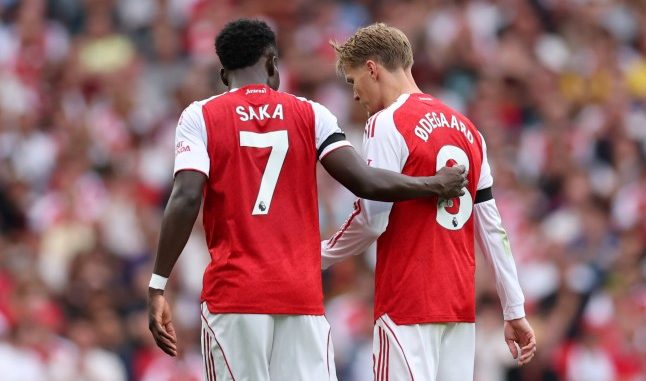
Arsenal are familiar with injury setbacks, though the only unexpected aspect of this latest wave is how early it has arrived in the campaign.
- Rio Ngumoha ‘banned’ from Liverpool dressing room despite first professional deal
- Every Liverpool Player’s Wages (2025)
- Barcelona’s honest feelings on Rashford emerge as they make decision on transfer
So far this season, Bukayo Saka, Martin Odegaard, William Saliba and Ben White have all missed time due to fitness concerns, with Kai Havertz yet to make an appearance after undergoing minor knee surgery in late August. Gabriel Jesus, meanwhile, has been absent since January. ..Continue Reading
Noni Madueke added to the injury list last weekend, leaving the pitch at half-time against Manchester City.
Things could have been more severe. Saka’s hamstring issue turned out to be less serious than initially feared, returning on Sunday after sitting out just three matches. Odegaard, despite injuring the same shoulder twice, has also avoided the kind of setback that sidelined him for three months last year.
Saliba returned to action against City and again featured midweek versus Port Vale, while Madueke’s knee problem is a medial ligament injury rather than an anterior one, with the ex-Chelsea attacker expected to be out for up to two months.
Top Stories:
As Cristhian Mosquera, Martin Zubimendi and Madueke have shown, Arsenal now possess the squad depth to handle short-to-mid-term absences, remaining unbeaten so far.
However, the regularity with which supporters are left anxious about the condition of key players is concerning.
Arsenal have long struggled to finish strong, and the unavailability of Saka, Odegaard, Havertz and Gabriel Magalhaes at pivotal moments last season played a role in another campaign without silverware.
Considering recent patterns, some may feel Arsenal suffer the worst injury luck in the league. Yet Chelsea, Crystal Palace, Sunderland, Manchester City and Tottenham are all managing similar or greater injury counts during a phase of the season known for heightened risk.
‘What we are seeing is players come back in for the first few weeks of the new season and in that time, we now usually see a spike in injuries,’ Stephen Smith, CEO and founder of Kitman Labs which specialises in injury welfare and performance analytics, told Metro. ‘That is generally what we will see across the Premier League compared to other portions in the year.
‘We see another spike around Christmas and New Year because there is so much congestion around that time period and again towards the end of the season.’
When injuries pile up, it’s natural for scrutiny to fall on medical teams, training intensity, or player self-care.
Last season, Saka, Havertz, Gabriel and Martinelli all dealt with hamstring problems in the latter half of the campaign—a widespread issue as teams endured a relentless match calendar. This time, Arsenal’s injuries span multiple types, a typical challenge during this stage of the season.
‘If they were all suffering with a specific type of injury, it would be easier to jump to that conclusion that something is going wrong on the training pitch,’ Smith said. ‘But we also know about these periods of the season where injuries are much more likely.
‘The first couple of weeks of the season is one of them and as we see right now with Arsenal, there are always more injuries occurring in this period than we do throughout the rest of the season. We will see a reduction over the next few weeks where things return to a more normal level.’
Managing this initial ‘injury spike’ is challenging, especially with clubs eager to start strong and new arrivals keen to make an impression.
Choosing to rotate and rest players early on can provoke criticism, but for Manchester City and Chelsea, it’s been a necessary move following their Club World Cup campaigns.
Chelsea’s victory over Paris Saint-Germain in New Jersey happened just 34 days before their league opener against Crystal Palace, and although City exited the tournament sooner, Pep Guardiola expressed serious concern about its long-term impact on his squad.
Moises Caicedo and Tijjani Reijnders are the only individuals from those two teams to have played every minute so far, and while both clubs have faced injuries elsewhere, early-season rotation may prove to be a smart strategy.
‘Seeing these spikes, it suggests there is potential for teams to leverage more rotation in those first couple of weeks of the season to potentially offset some of that,’ Smith said. ‘If we know going into the season this is a period where there is a higher risk of potential injuries, potentially we should be using more rotations game to game in that period.
‘I know everyone wants to get off to get off to the perfect start and get wins under their belts but they also want to keep their best players out there and available.’
So what can Arsenal do? ‘Without having access to all the information as to how all those players are responding day to day, it is impossible to say if there are things they can do to help the situation,’ Smith said.
‘But sitting on the side we sit on in regards to the use of data and what we see from it, often times we can learn things. The question is not whether there is anything Arsenal could have done to prevent those issues, but how they can learn from them using the information they have to leverage things in the future and prevent other injuries in the future.’

Leave a Reply